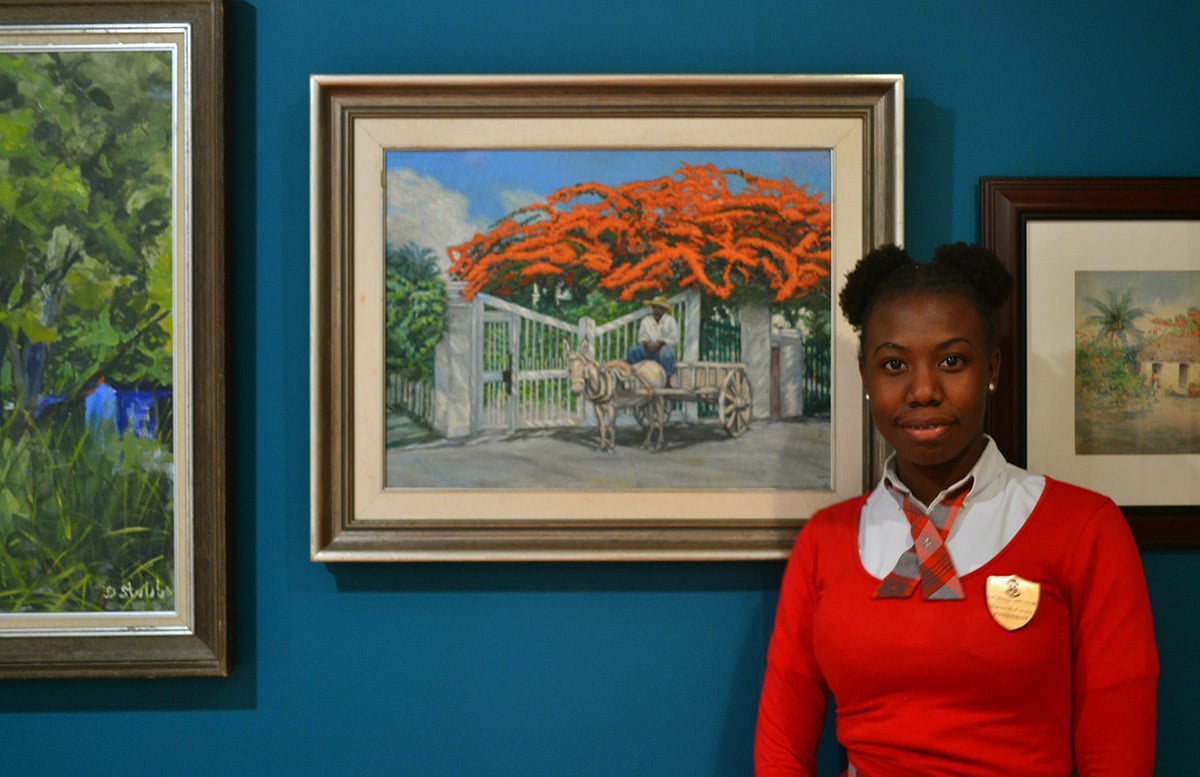By Nakoa McKenzie, Student at C.R. Walker Secondary High School.

Nakoa McKenzie stands with Sweeting’s painting “Two Natives at the Gate” showcased in the permanent exhibition, “Revisiting an Eye For The Tropics” on view at The National Art Gallery of The Bahamas through the end of March 2018. Images courtesy of The NAGB.
Introduction:
The National Art Gallery of The Bahamas prides itself on having a healthy and robust community outreach programme with high schools, especially those in our community. Every semester we work with schools to find students to partner with, especially those who have an interest in the arts and cultural initiatives. This extends to work-study opportunities, building and reinforcing how relevant research and data management is with regards to development and strategy. We give students the opportunity to thoroughly integrate with the NAGB team for a week or two – the time remains flexible- and during the first two days of observation, they have an idea of a more significant way in which they’d like to contribute.
This week, we are happy to have Nakoa McKenzie, who is a 12th-grade student at C. R. Walker Secondary High School, here with us. She is 17 years old, president of the art club, and wants to be a graphic designer or a gallery owner when she ‘grows up’. Initially, she came to do work in our library, but as our system is currently in flux, she worked between the curatorial and education departments to determine her fit. However, seeing that she was keen on writing and looking at art, we gave her a tour of the exhibitions, and she was smitten. To cultivate her eye and discernment, we invited her to choose one piece currently on view and write on it. Here we present her thoughts on the painting titled “Two Natives at the Gate” by William Sweeting.

“Two Natives at the Gate” (1971), William Sweeting, oil on canvas, 14 x 18. Part of the Dawn Davies Collection.
Two Natives at the Gate
In the 1800s the majority of Bahamians who were of African descent were viewed as the inferior race because of a lack of understanding and the clash of cultures and religions. This stereotype of the African diaspora (the term used to refer African people living outside the continent) influenced the society of the entire Bahamas. In those days the Black people were considered animals and used as objects to pick cotton, cut sugar and clear fields. The West Indies (which is now called the Caribbean) was seen as a land filled with disease or even a land of exile, mainly because of how underdeveloped and unpopulated it was (by European standards).
It began to change in the late 1700s when the Loyalists, along with their slaves, emigrated to The Bahamas after Britain lost the American Revolutionary War. They established plantations that were successful for a few years, then collapsed. The American Civil War contributed to a boost in the tourism industry in the mid-1800s, which was augmented by artists who visited The Bahamas and depicted and framed it as an attractive haven with sunny days, white sand, clear waters, great accessible ports, fantastic fishing grounds and quiet and safe neighborhoods.
William Sweeting’s 1971 painting, “Two Natives at the Gate,” shows a single Black man in a carriage being pulled by a donkey, passing a fancy gate with a lovely garden. The title of the work—equating the man and animal—shows that the artist sees the Black Bahamian as nothing more than a tool to be used for manual labour. Because Sweeting is believed to be a white male, a part of the so-called “master-race,” he has the mindset that he’s above all races.
The vibrant colours used in this oil painting were a more expressionist and realistic style. The artist used a dry brushing technique to blend the colours, stippling–the creation of a pattern simulating varying degrees of solidity or shading by using small dots–was used to create the texture in the trees.
Even though it is a simple, vibrant painting, it could have a deeper meaning. The donkey and the Black man represent forerunners: laborious and determined but a dull and uneducated population. The gate symbolises the segregation between white and Black communities. The carriage represents the next generation, who will build The Bahamas from the foundation given to them by their forefathers. Finally the garden represents the riches and the birthright held back from the Bahamian people.
In conclusion, society in the 1900s was very unfair and inhumane based on the fact that they believed that the donkey and a man had the same value. The artwork itself was very captivating and fulfilled its purpose of framing The Bahamas as this extraordinary paradise to stimulate migration and the development of the colony (e.g. the building of the British Colonial Hilton). Nevertheless, I still have to thank Sweeting as an artist along with the other so-called ‘white supremacists’ who helped The Bahamas to become one of the most travelled tourist destinations in the world- an economic model that was built on the backs of hundreds of slaves and underpaid Black Bahamian labourers. If it wasn’t for artwork like “Two Natives at the Gate,” along with the other paintings before and after its time, combined with the unpaid labour of the African diaspora, The Bahamas may not have been this successful.